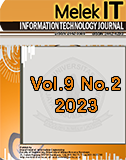ANALISIS USABILITY SISTEM MANAJEMEN PEMBELAJARAN DI WASKITA UNIVERSITAS AMIKOM: PENDEKATAN DENGAN SYSTEM USABILITY SCALE
Main Article Content
Abstract
This research was conducted at Amikom University Yogyakarta, a university that responded adaptively to the pandemic by developing the Waskita Learning Management System (LMS). Waskita LMS functions as a supporting platform for teaching and learning activities, facilitating the exchange of lecture materials, assignment collection, and quizzes between lecturers and students. Usability analysis was carried out using the System Usability Scale (SUS) method, a simple and reliable user testing method. The analysis results show that LMS Waskita received an average SUS score of 54.2, falling into the Not Acceptable category, indicating the need for improvement. Apart from calculating the SUS, an analysis of respondents' suggestions was also carried out to strengthen the evaluation results. This research provides valuable insights for developing and improving the quality of the Waskita LMS to improve user experience and usability.
Downloads
Article Details

This work is licensed under a Creative Commons Attribution-ShareAlike 4.0 International License.
How to Cite
References
F. G. Sembodo, G. F. Fitriana, and N. A. Prasetyo. 2021. Evaluasi Usability Website Shopee Menggunakan System Usability Scale (SUS). J. Appl. Informatics Comput., vol. 5, no. 2, pp. 146–150, 2021, https://doi.org/10.30871/jaic.v5i2.3293
Jhonbenly, Lisemai Sempanasaf. 2022. Evaluasi dan Analisis Usability Website Teknik Industri Unissula Dengan Pendekatan Ergonomic Software dan Pengujian Usability Testing. Undergraduate Thesis, Universitas Islam Sultan Agung. Semarang. http://repository.unissula.ac.id/28001/
U. U. Sufandi and D. A. Aprijani. 2022. Pengukuran Usability Aplikasi Web Menggunakan Metode Pssuq (Study Kasus: Aplikasi Sitta Universitas Terbuka). JST (Jurnal Sains dan Teknol., vol. 11, no. 2, pp. 249–256, https://doi.org/10.23887/jstundiksha.v11i2.43534
M. Marsuki, R. Rasmila, R. Avindo, and D. Safitri. 2022. Analisis Website Tribunnews Menggunakan Sus (System Usability Scale). Pros. Semin. Has. Penelit. Vokasi, vol. 3, no. 2, pp. 217–221
D. W. Ramadhan. 2019. PENGUJIAN USABILITY WEBSITE TIME EXCELINDO MENGGUNAKAN SYSTEM USABILITY SCALE (SUS) (sTUDI KASUS: WEBSITE TIME EXCELINDO). JIPI (Jurnal Ilm. Penelit. dan Pembelajaran Inform., vol. 4, no. 2, p. 139, https://doi.org/10.29100/jipi.v4i2.977
I. Maryati, E. I. Nugroho, and Z. O. Indrasanti. 2022. Analisis Usability pada Situs Perpustakaan UC dengan Menggunakan System Usability Scale. J. Media Inform. Budidarma, vol. 6, no. 1, p. 362, https://doi.org/10.30865/mib.v6i1.3472
A. Fatmawati, “Evaluasi Usability pada Learning Management System OpenLearning Menggunakan System Usability Scale,” INOVTEK Polbeng - Seri Inform., vol. 6, no. 1, p. 120, 2021, https://doi.org/10.35314/isi.v6i1.1881
Arvin Claudy Frobenius, Andi Sutra Kusumaningrum, Angga Arindra Shonta, Nur Andini Khoirunnisa, Nurdini Kharomadhona, & Wisnu Yudo Untoro. 2023. Evaluasi Usability Testing Aplikasi lLMS Waskita Dengan Metode System Usability Scale (SUS). MELEKIT Vol 9 No 1, pp.1-8, https://melekit-if.uwks.ac.id/melekit/article/view/289
D. Yana and A. Adam. 2019. Efektivitas Penggunaan Platform Lms Sebagai Media Pembelajaran Berbasis Blended Learning Terhadap Hasil Belajar Mahasiswa. J. Dimens., vol. 8, no. 1, pp. 1–12, https://doi.org/10.33373/dms.v8i1.1816
L. Amanda, F. Yanuar, and D. Devianto. 2019. Uji Validitas dan Reliabilitas Tingkat Partisipasi Politik Masyarakat Kota Padang. J. Mat. UNAND, vol. 8, no. 1, p. 179, https://doi.org/10.25077/jmu.8.1.179-188.2019
M. A. Kosim, S. R. Aji, and M. Darwis. 2022. Pengujian Usability Aplikasi Pedulilindungi Dengan Metode System Usability Scale (Sus). J. Sist. Inf. dan Sains Teknol., vol. 4, no. 2, pp. 1–7, https://doi.org/10.31326/sistek.v4i2.1326
A. W. Soejono, A. Setyanto, and A. F. Sofyan. 2018. Evaluasi Usability Website UNRIYO Menggunakan System Usability Scale (Studi Kasus: Website UNRIYO). Respati, vol. 13, no. 1, pp. 29–37, 2018, https://doi.org/10.35842/jtir.v13i1.213
T. Yuliyana, I. K. R. Arthana, and K. Agustini. 2019. Usability Testing pada Aplikasi POTWIS. JST (Jurnal Sains dan Teknol., vol. 8, no. 1, pp. 12–22, https://doi.org/10.23887/jstundiksha.v8i1.12081
Soetam Rizky Wicaksono, & Vennina Githa Ananta. 2023. Usability Testing Situs Daring Sebagai Evaluasi User Experience (Studi Kasus Situs PERUMDAM Among Tirto). Jurnal Sistem Dan Informatika (JSI), 17(1), 13-17. https://doi.org/10.30864/jsi.v17i1.452
R. Andriani and A. Sa’di. 2022. Evaluasi Usability E-Learning Moodle Menggunakan SUS Questionnaire Pada Perguruan Tinggi. Sist. Sist. Inf., vol. 11, no. 2, pp. 506–514, [Online]. Available: http://sistemasi.ftik.unisi.ac.id
Evans Fuad, Regiolina Hayami, and A. Kharisma. 2021. Evaluasi Usabilitas Website E-Learning Umri Terhadap Mahasiswa Umri Menggunakan Metode Usability Testing. J. CoSciTech (Computer Sci. Inf. Technol., vol. 2, no. 2, pp. 74–82, https://doi.org/10.37859/coscitech.v2i2.3029
K. T. Nugroho, B. Julianto, and D. F. Nur MS. 2022. Usability Testing pada Sistem Informasi Manajemen AKN Pacitan Menggunakan Metode System Usability Scale. J. Nas. Pendidik. Tek. Inform., vol. 11, no. 1, p. 74, https://doi.org/10.23887/janapati.v11i1.43209
A. A. Suhendra, G. A. A. Putri, and G. M. A. Sasmita. 2021. Evaluasi Usability User Interface Website Menggunakan Metode Usability Testing Berbasis ISO 9241-11. J. Ilm. Teknol. dan Komput., vol. 2, no. 3, pp. 31–38, [Online]. Available: https://ojs.unud.ac.id/index.php/jitter/article/download/77600/41265
A. B. Shazkya, R. I. Rokhmawati, and .... 2018. Analisis Pengalaman Pengguna Dengan Menggunakan Mixed-Methods Approach Studi Pada Website Coppamagz. J. Pengemb. …, vol. 2, no. 9, pp. 3000–3005, [Online]. Available: http://j-ptiik.ub.ac.id/index.php/j-ptiik/article/view/2103
R. Nurlistiani and N. Purwati, “Interpretasi Pengujian Usabilitas E-Learning di Masa Pandemi COVID-19 Menggunakan System Usability Scale,” Pros. Semin. Nas. Darmajaya, vol. 1, no. 0, pp. 164–171, 2021, [Online]. Available: https://jurnal.darmajaya.ac.id/index.php/PSND/article/view/2949
M. A. Maricar and D. Pramana. 2020. Usability Testing pada Sistem Peramalan Rentang Waktu Kerja Alumni ITB STIKOM Bali. J. Eksplora Inform., vol. 9, no. 2, pp. 124–129, 2020, https://doi.org/10.30864/eksplora.v9i2.326





